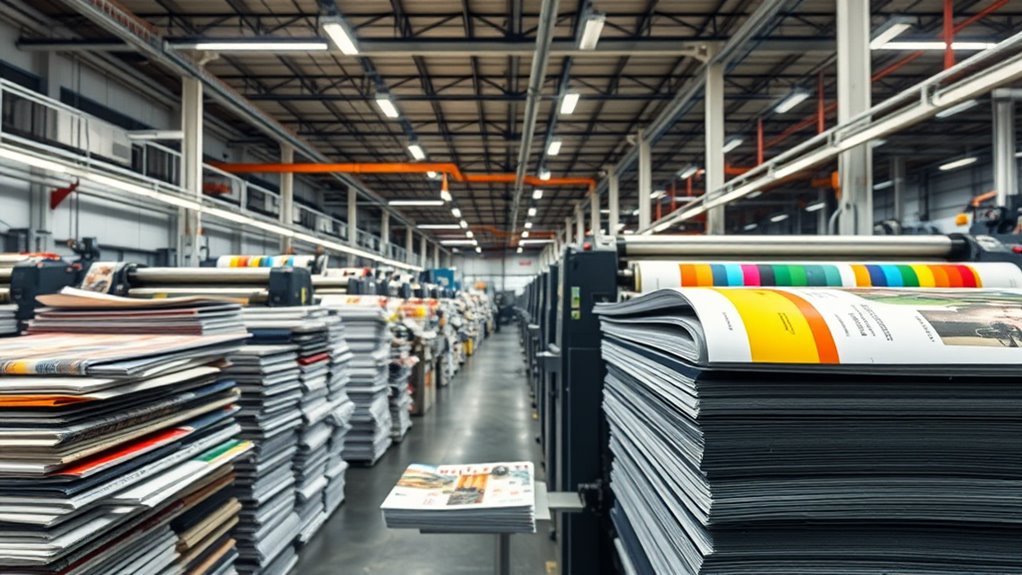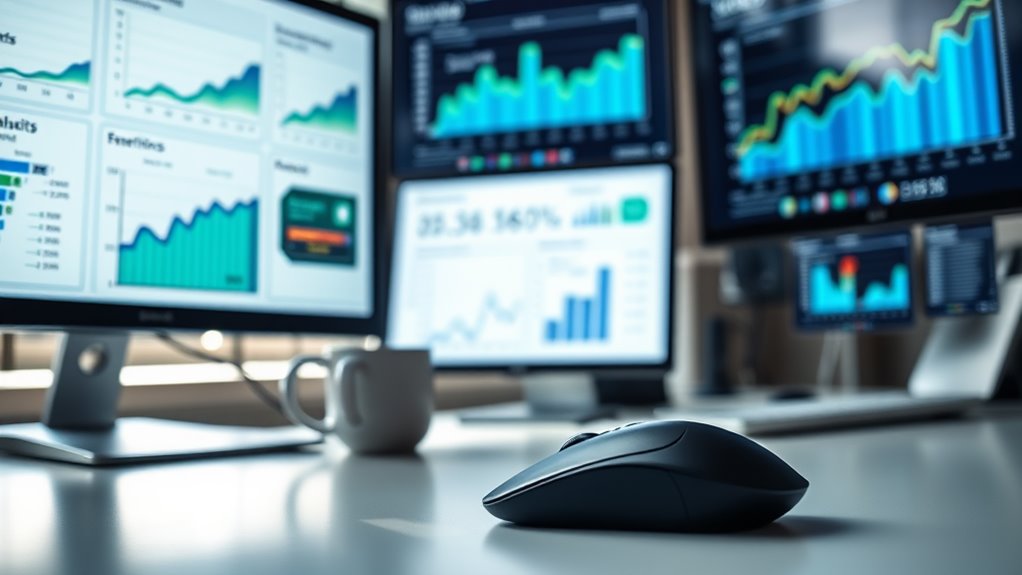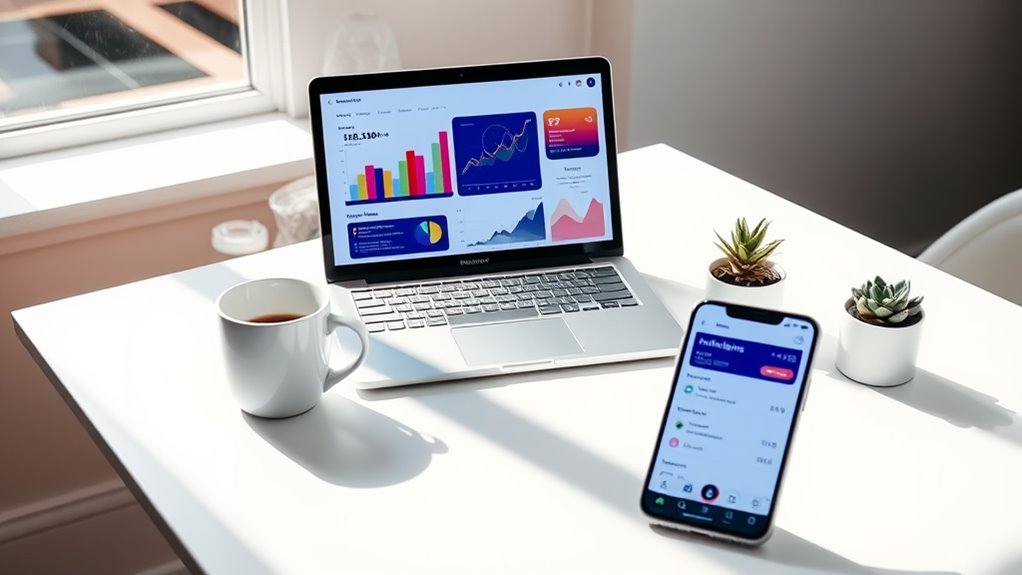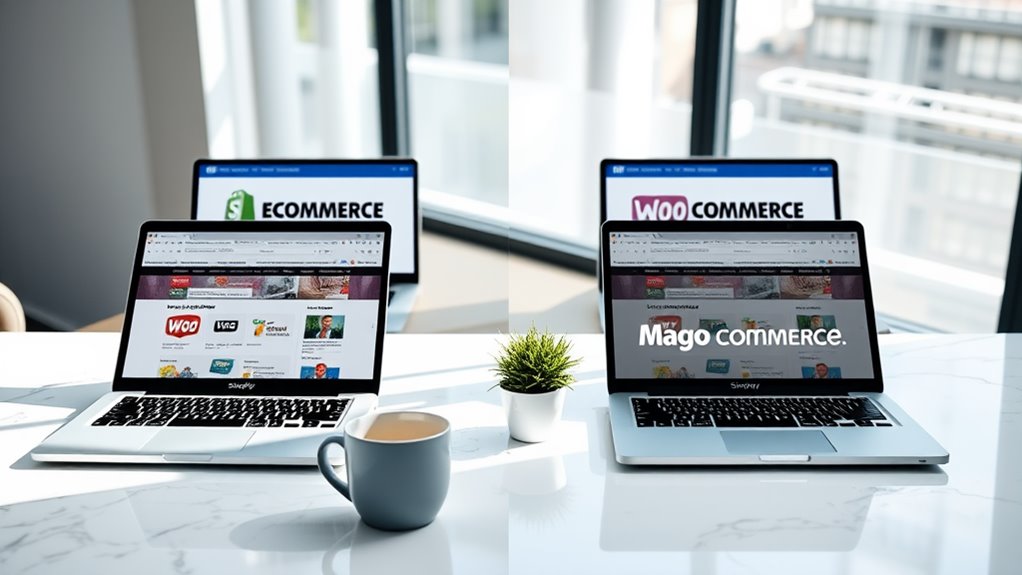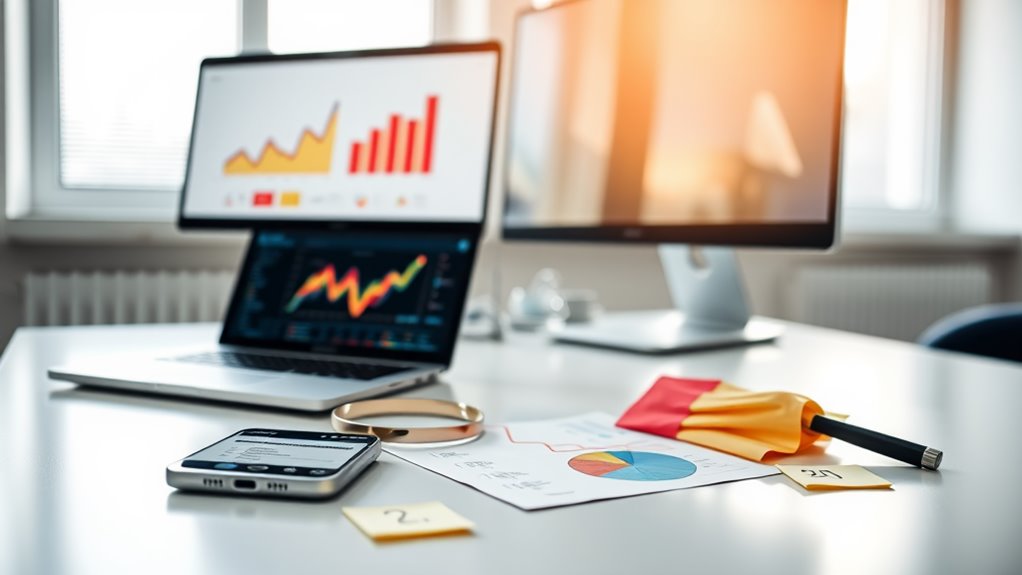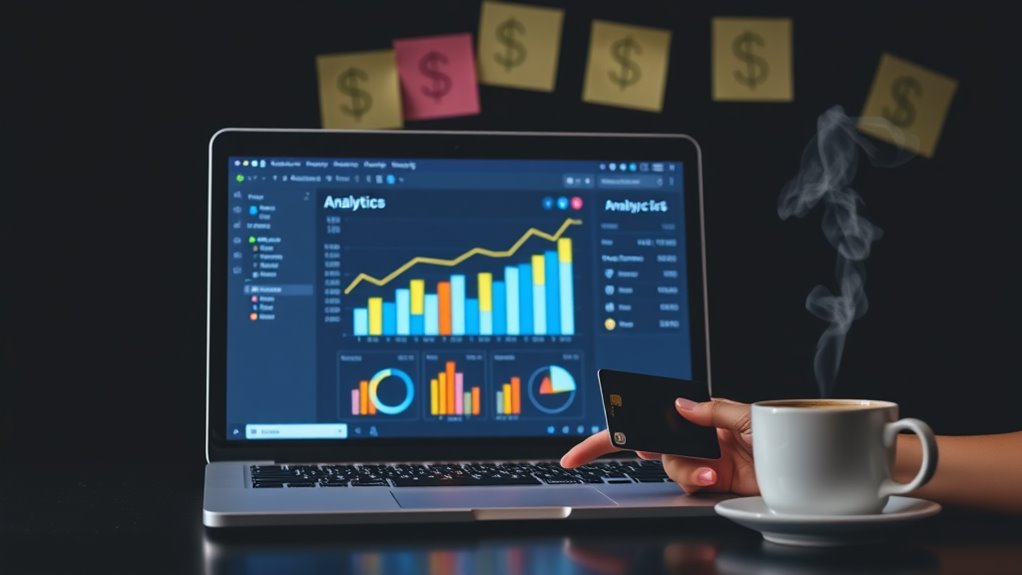Commercial printing encompasses professional-grade printing services for businesses and organizations that need high-quality printed materials at scale. You'll find two main methods: digital printing for shorter runs under 500 pieces with quick turnaround times, and offset lithography for larger quantities that benefit from lower per-piece costs. Common applications include marketing materials like brochures and catalogs, operational documents such as training manuals, and specialty items like promotional products. Your printing needs might range from basic business cards to large-format banners, with costs varying based on quantity, paper type, color usage, and finishing requirements. Understanding these options will help you make cost-effective decisions for your printing projects.
Key Takeaway
- Commercial printing encompasses professional printing services for businesses, including marketing materials, operational documents, and specialty items at scale.
- It utilizes various printing methods like offset lithography, digital printing, and large format printing for different volume requirements.
- High-volume production capabilities distinguish commercial printing, with equipment that can produce thousands of pieces per hour.
- Commercial printing serves business needs through professional-grade materials like brochures, catalogs, business cards, banners, and promotional products.
- It involves specialized equipment, finishing processes, and quality control systems to deliver consistent, professional results for business applications.
Types of Commercial Printing Services
Commercial printing encompasses a diverse range of services designed to meet various business and marketing needs. You'll find that modern printing services have evolved to offer sophisticated solutions for your company's visual communication requirements.
Common Commercial Printing Categories:
- Offset Lithography
- Perfect for high-volume projects like magazines and catalogs
- Delivers exceptional color accuracy and detail
- You'll typically see cost benefits when ordering 500+ pieces
- Digital Printing
- Ideal for short runs and variable data printing
- Allows you to customize each piece with unique information
- Offers quick turnaround times, usually within 24-48 hours
- Large Format Printing
- Creates impactful signage, banners, and displays
- Handles sizes up to 16 feet wide
- Includes both indoor and outdoor applications
- Specialty Printing
- Incorporates foil stamping, embossing, and die-cutting
- Provides unique finishes and textures
- You'll find options for special materials like fabric and metal
You'll need to evaluate factors like quantity, turnaround time, and material requirements when selecting the right printing service for your project. Each method offers distinct advantages that you can leverage to achieve your specific marketing objectives.
Commercial Printing Equipment
The specialized services discussed above require advanced machinery to deliver professional results. You'll find that modern commercial printing facilities invest heavily in equipment that combines precision, speed, and versatility.
Essential Commercial Printing Equipment:
- Digital Presses
- HP Indigo and Xerox iGen systems for short-run projects
- Variable data capabilities for personalized printing
- Quick turnaround times with minimal setup
- Offset Printing Presses
- Sheet-fed presses for high-volume jobs
- Web presses that handle continuous paper rolls
- Can print up to 18,000 sheets per hour
- Finishing Equipment
- Industrial paper cutters and trimmers
- Perfect binding machines
- Folding and scoring devices
- Laminating systems
Supporting Technologies:
- Color management systems
- Plate-making equipment
- Pre-press workflow software
- Quality control devices
You'll need to evaluate that each piece of equipment serves specific purposes in the printing process. While digital presses excel at short runs and variable data printing, offset presses remain the go-to choice for large-volume projects where cost-per-piece matters most. Your choice of equipment will depend on your project's requirements, timeline, and budget constraints.
Digital Vs Offset Printing
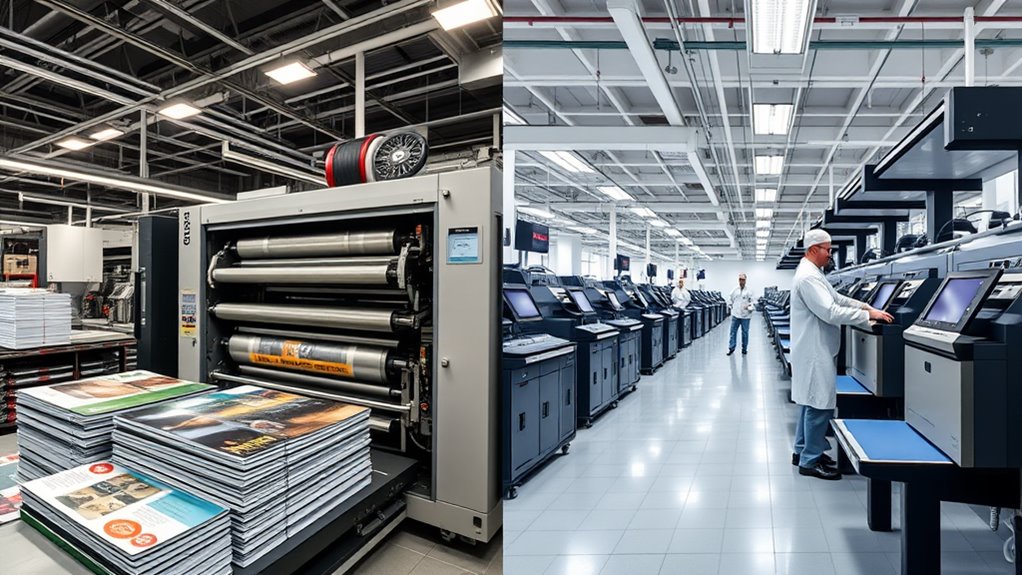
When choosing between digital and offset printing methods, you'll need to understand their distinct advantages and limitations for your project.
Digital Printing Advantages:
- Perfect for short runs (under 500 pieces)
- Quick turnaround times, often within 24-48 hours
- Variable data capabilities for personalization
- Lower setup costs and minimal waste
- Consistent color matching across runs
Offset Printing Benefits:
- More cost-effective for large runs (over 500 pieces)
- Superior color accuracy and PMS matching
- Higher quality printing on specialty materials
- Better handling of large solid color areas
- More paper stock options available
Key Considerations for Your Choice:
Cost Factors:
- Digital: $0.10-0.30 per piece for short runs
- Offset: $0.03-0.15 per piece for large runs
Quality Expectations:
You'll find offset printing provides slightly sharper images and more precise color matching, while digital printing offers 95% comparable quality for most applications. If you're printing fewer than 500 pieces, digital printing will typically be your most cost-effective option. However, if you're producing thousands of pieces or require exact PMS color matching, offset printing becomes the more economical choice.
Common Commercial Printing Applications
Businesses across all industries rely on commercial printing services for up to dozens of essential marketing and operational materials. You'll find these applications spanning both internal operations and customer-facing communications, serving multiple business objectives.
Common Marketing Materials:
- Brochures and catalogs (48% of businesses use these as lead generators)
- Business cards and letterhead
- Direct mail pieces and postcards
- Banners, posters, and signage
- Trade show displays and materials
Operational Documents:
- Training manuals and employee handbooks
- Forms and contracts
- Reports and presentations
- Labels and packaging
- Invoices and statements
Specialty Items:
- Promotional products and merchandise
- Custom calendars
- Corporate gifts
- Point-of-purchase displays
- Vehicle wraps and decals
You'll need to evaluate your specific requirements when choosing printing applications, as each serves distinct purposes. For example, if you're launching a product, you might need a combination of catalogs (for detailed information), posters (for visibility), and brochures (for quick reference). Modern commercial printers can help you select the most effective applications for your goals while ensuring consistent branding across all materials.
Cost Factors in Commercial Printing
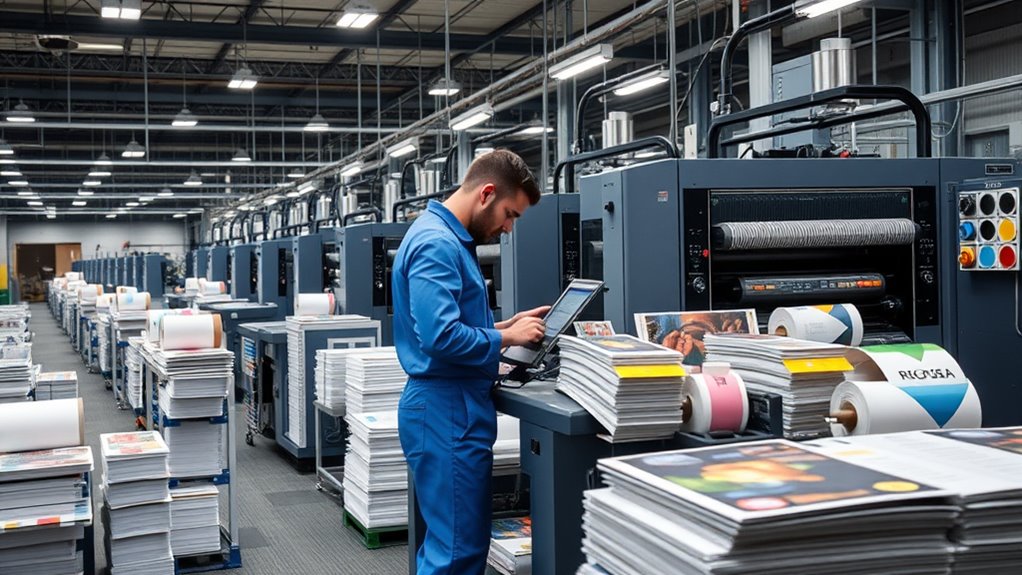
Understanding commercial printing costs requires examining multiple variables that impact your final price point. You'll need to take into account both fixed and variable costs to accurately budget for your printing projects.
Key Cost Components:
- Print quantity – Higher volumes typically reduce your per-piece cost
- Paper selection – Premium stocks can increase costs by 20-40%
- Color usage – Full-color printing costs 30-50% more than single-color
- Size and format – Non-standard sizes require special handling
- Finishing requirements – Die-cutting, binding, or lamination add expenses
Project-Specific Factors:
- Turnaround time – Rush orders can double your base costs
- Design complexity – Intricate designs require additional setup time
- Print method – Digital vs. offset affects pricing for different quantities
- Customization – Variable data printing adds 15-25% to basic costs
- Geographic location – Regional labor and material costs vary
You'll find that understanding these factors helps you make cost-effective decisions. For example, you might save 25-30% by choosing standard sizes and paper stocks. It's essential to discuss these variables with your printer early in the planning process to optimize your budget and avoid unexpected charges.
Conclusion
Like a well-oiled machine, commercial printing stands ready to transform your ideas into tangible reality. Whether you're leaning toward digital's flexibility or offset's cost-effectiveness for large runs, you'll find that modern printing solutions can meet virtually any business need. As you've seen, from business cards to billboards, commercial printing continues to evolve with technology while remaining a cornerstone of professional marketing and communication.

